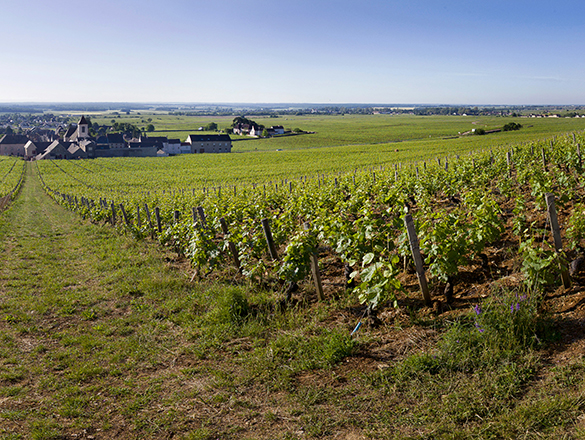

The vineyards of Bourgogne produce some great wines with a historical and international reputation. However, the region is not simply limited to its iconic appellations. In addition to its Village Premier Cru and Grand Cru AOCs, it also produces a range of wonderful Régionale and Village appellations to explore.
You will also find a full list of the Bourgogne’s Climats and lieux-dits on this page.
Check out the complete list of the 84 Bourgogne appellations.
However, your exploration has only just begun. Bourgogne wines have never before offered such high quality. Besides our range of internationally celebrated wines, try some of our lesser-known appellations where there are lots of surprises in store.
And for a fun way to find out more about the wines on offer, try out our “Which Bourgogne wine is right for me?” quiz, or check out Bourgogne Maps to take an interactive tour of the region.
Grand Cru appellation
VIGNOBLE DE LA CÔTE DE NUITS
4 janvier 1939
Red wines only - Pinot Noir.
Area under production*:
1 hectare (ha) = 10 000 m² = 24 ouvrées.
CLOS SAINT-DENIS: 6.23 ha
CLOS DE LA ROCHE: 16.73 ha
CLOS DES LAMBRAYS: 8.71 ha
CLOS DE TART: 7.39 ha
Average annual yield**:
1 hectolitre (hl) = 100 litres = 133 bottles.
210 hl (27,930 bottles)
537 hl (71,421 bottles)
238 hl (31,654 bottles)
198 hl (26,334 bottles)
*In 2022 **5-year average, 2017-2021
Appellations Grands Crus of the Côte de Nuits region (Côte-d’Or).
Producing commune: Morey-Saint-Denis.
On the label, the words GRAND CRU must appear immediately below the name of any of these appellations in characters of exactly the same size.

Diversity is to be expected as each Grand Cru has its own personality. To the eye, this wine is plain ruby, sometimes a bit darker. Veiled in strawberry and violet, the Clos de Tart offers both robustness and charm. Quite tannic when young, it softens with age while gaining in complexity. The Clos des Lambrays is a true aristocrat, fully rounded in youth and with added depth and gravity as the years go by. The Clos Saint-Denis impresses by its finely-tuned nuances – this wine is the Mozart of the Côte de Nuits. The Clos de la Roche is firmer, deeper and more serious, closely akin to Chambertin. Aromas of humus and truffle are often precursors to notes of small red or black fruits. A small part of the Bonnes-Mares appellation lies in this commune, but the greater part is in Chambolle-Musigny. (See Appellation sheets No.5).

Intense and full-bodied when fully mature, these wines have a densely tannic texture and an aromatic richness which makes them a fitting – and equal - partner for feathered game. They are perfect, too, with a rib steak and, for lovers of Asian cuisine, adapt well to the aromatic intensity of glazed poultry. Their supple but virile tannins go well with veal (braised or in sauce) and with roast or braised lamb. One must also not forget their invaluable affinity for strong flavoured soft-centred cheeses.
Serving temperatures: 12 to 13°C for young wines, 15 to 16°C for older wines.

Of all the villages of the Côte de Nuits, Morey-Saint-Denis is one of the most fruitful in terms of the number of its Grands Crus. The Clos de Tart, which remains a solely-held entity, was founded by the Cistercians of Tart in 1141. Since that date, it has been owned by only three families. The Clos Saint-Denis came on the scene in the 11th century, thanks to the fortress of Vergy. The Clos de la Roche and Clos des Lambrays are both semi-monopoles and both have long histories which have involved some adjustment of boundaries between Climats. The Clos de la Roche and Clos Saint-Denis were awarded their appellation Grand Cru on 8 December 1936, Clos de Tart on 4 January 1939, and Clos des Lambrays 27 April 1981. Facing east or slightly south of east at around 250 metres above sea-level, these Climats may be seen as a southerly extension of the Grands Crus of Gevrey-Chambertin. First comes the Clos de la Roche, then Clos Saint-Denis followed by Clos des Lambrays, and finally Clos de Tart leading to Bonnes-Mares.

Limestone dominates in the Clos de la Roche where the soil is barely 30 cm deep with few pebbles but with large boulders which give the Climat its name. In the Clos de Tart, scree-derived soils 40-120 cm thick cover the underlying limestone. The Upper part of the Clos des Lambrays is marly with claylimestone soil further down. The Clos Saint-Denis at the foot of the slope has pebble-free brown limestone soils which contain phosphorus (like Chambertin) and clay (like Musigny).
